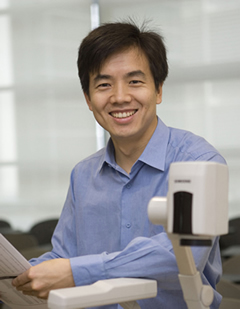即可将网页分享至朋友圈
由电子科学与工程学院主办的“电子论坛”第40期邀请到美国光学学会杂志《Optics Express》副主编,APS Fellow XIONG QIHUA,与我校师生共同探讨二维半导体和异质结中的超快电荷转移。具体安排如下,欢迎感兴趣的师生参加。
主 题:Ultrafast Charge Transfer in 2D Semiconductors and Heterostructures
时 间:2018年10月12日(周五)14:00-16:00
地 点:清水河校区五号科研楼351
主讲人:Prof. Qihua Xiong(Deputy Editor of the Optics Express, APS Fellow, Professor of Nanyang Technological University)
主讲人简介:

XIONG QIHUA is a professor hired by the School of Mathematical Sciences and the School of Electrical and Electronic Engineering of Nanyang Technological University. In 1997, he graduated from the Physics Department of Wuhan University. In 2000, he obtained a master's degree from the Shanghai Institute of Applied Physics. In 2006, he received his Ph.D. from Pennsylvania State University, and his tutor is Professor Peter C. Eklund. In 2006-2009 he was a postdoctoral researcher at the Charles Lieber Research Group at Harvard University. In early 2009, he was supported by the National Research Foundation of Singapore and joined Nanyang Technological University in June of that year as an assistant professor of Nanyang. He received tenure in 2014 and was promoted to full professor in 2016. Since 2017, he has been responsible for teaching affairs. Professor XIONG QIHUA takes steady state and transient spectroscopy as the main experimental methods, taking light and matter interaction as the research topic, focusing on the physical mechanism and quantum regulation of photonic-phonon-electron coupling in low-dimensional semiconductor nanomaterials. He has made a series of influential work on a series of cutting-edge topics such as nanophotonics and surface plasmons, laser refrigeration, and optical properties of two-dimensional semiconductor materials. He has published more than 190 articles in a series of internationally renowned magazines such as Nature, Nanocommunication and Advanced Materials. And the articles has been reported by world-renowned magazines and mass media. The total number of citations has exceeded 8,300. His outstanding research has received many awards and recognition, such as the Singapore Physical Society Nanotechnology Award (2015), the Singapore National Research Foundation NRF Investigatorship Award (2014), and the Nanyang Technological University Nanyang Research Excellence Award (2014). In April 2018, he served as the deputy editor of the Optics Express, the flagship magazine of the Optical Society of America. In September of the same year, he was elected as a Fellow of the American Physical Society.
报告简介:
2D semiconductors, such as transitional metal chalcogenides and black phosphorus, have attracted considerable attention due to fascinating physical properties a wide range of applications in valleytronics, optoelectronics and superconductivity. The interlayer interaction is particularly important in both homogenous few-layer systems and heterogeneous structures formed by “lego” fashion, which underpins the foundation for rational engineering towards unprecedented functionality. In this talk, I will introduce our work on unique interlayer charge transfer mechanism in 2D semiconductor monolayer heterostructures leads to an interesting blinking phenomenon, whereby a bright state emission occurs in one monolayer while a dark state emission occurs in the other, and vice versa. Such correlated blinking can be probed in detail by steady-state and transient spectroscopy measurements, which uncovered an ultrafast charge transfer process ~ 120 fs, providing new platform to study the long-standing puzzling blinking phenomenon in nanomaterials. Secondly, I will present how the charge transfer by a gate modulation breaks the symmetry in a bilayer sample such that a charge-induced second harmonic generation is produced, due to a confined charging in W-atomic plane and a screening effect. This bilayer system can be further modulated by introducing plasmonic structures, from which an ultrafast plasmonic hot carrier injection (~ ps) can lead to symmetry breaking, as such a second harmonic generation is produced. Our study creates opportunity for the ultrafast all-optical control of SHG in an all-optical manner that may enable a variety of applications.
电子科学与工程学院
2018年10月9日
编辑:助理编辑 / 审核:罗莎 / 发布:陈伟


